
IN THIS ISSUE: TRAILS CHALLENGE MILESTONE P. 3 BOARD MEMBERS RETIRE P. 4 VISITOR CENTERS REFRESH P. 12 YOUTH PROGRAMS INSPIRE FUTURE ENVIRONMENTAL STEWARDS
Next WINTER 2023
Generation
PARKS FOR EVERYONE
Welcome to the start of a new year, one with lots of new and exciting things happening at the Regional Parks Foundation. I have recently joined the East Bay Regional Park District as its assistant general manager of Public Affairs and am serving as interim executive director for the Foundation. I bring more than 30 years of communications and nonprofit experience. As an avid park user, I am committed to the Foundation’s mission and feel honored to work to make our parks for everyone.
As a longtime East Bay resident who has hiking shoes at the ready, I am grateful to the Foundation and its many donors, members and friends for your support of the Park District and its programs and initiatives to enrich lives and reach out to those who have yet to discover our amazing parks with 1,250 trails and 55 miles of shoreline.
Thanks to the success and commitment of the Foundation’s board of directors and staff, we are pleased to share news about Foundation-supported projects that will further enhance the visitor experience today and in the future—such as youth programs that help foster the next generation of stewards, and improvements at some of the District’s well-loved visitor centers.
The Trails Challenge also celebrates its 30-year anniversary in 2023 with 20 newly selected trails of varying difficulty, including options that are accessible to hikers of all abilities. We invite you to come experience and celebrate nature at your parks, and bring family or friends.
Thank you for your support, and happy trails in the year ahead!
Shiu Interim Executive Director, Regional Parks Foundation Assistant General Manager, Public Affairs East Bay Regional Park District


REGIONAL PARKS FOUNDATION
Board of Directors
PRESIDENT Les Hausrath Attorney, retired
VICE-PRESIDENT Holly Potter Gordon and Betty Moore Foundation
TREASURER
Bruce Kern Economic Consultant
SECRETARY
John Martin Drake’s Brewing Company
DIRECTORS
Bob Brown Western States Petroleum Association, Bay Area Region
Nik Dehejia Conservation Society of California/ Oakland Zoo
Renee Kemp Media and Communications Consultant
Stephanie Ledesma
Kaiser Permanente
Amber Miksza REI Inc.
Ravi Poorsina Blue Shield of California

Taj Tashombe Canyon Oaks Advertising Services
Jack Uhalde NBC Bay Area
Keith White Salesforce Inc.
Geoffrey Zimmerman, CFP Zimmerman Wealth Advisory Group LLC





















Copyright 2023, Regional Parks Foundation, P.O. Box 2527, Castro Valley, CA 94546, 510-544-2202, www.RegionalParksFoundation.org. A biannual publication of the Regional Parks Foundation.
Sabrina Landreth General Manager East Bay Regional Park District
Fun facts about the East Bay Regional Park District



EX OFFICIO


Dennis Waespi President, Board of Directors, East Bay Regional Park District
GENERAL MANAGER
Sabrina Landreth
East Bay Regional Park District
INTERIM EXECUTIVE DIRECTOR
Susan Shiu
Regional Parks Foundation
How long it would take to walk the 1,330 miles of trails within the parklands (estimated using the Walking Englishman walk time calculator)
YOU KNOW
DID
KennedyGrove Wildcat BayTrail HorseTrail ALAMEDACOUNTY Pinole Ridge Crockett Trampas Sibley Canyon Point Carquinez Rock Botanic Grove Temescal Bay Point Eastshore Dry Creek/ Chabot Canyon Huckleberry Roberts Hayward Oyster Bay King, Jr. Crown Beach Castro Canyons Sunol Peak Coyote Ardenwood Ridge Del Wilderness Camp Arroyo Bishop Mines Valley Morgan Territory Sycamore Vasco Brushy Byron Ranch Antioch/ Oakley Big Break Vargas Valley Dumbarton Quarry Campground on the Bay Point Shoreline Molate Thurgood San PabloBay Bay SacramentoRiver Other Open Space 125,470
The number of acres in the 73 regional parks 31 The number of regional interpark trails 1,330+ Miles of trails within the Park District 532 hours and 29 minutes
2 > REGIONAL PARKS FOUNDATION THIS PAGE: EBRPD COVER: EBRPD
Susan
TRAIL ACCESS FOR ALL
This year’s Trails Challenge celebrates its 30th anniversary by welcoming as many participants as possible

For three decades, walkers, runners, cyclists and horseback riders have headed out on paths across the Park District to take part in the annual Trails Challenge, forging fitness habits and friendships along the way. Beginning in January, the program offers participants the chance to experience a range of parks while earning a collectible pin for embarking on at least five of 20 trails (or 26.2 miles) in those areas.
“It’s really great that people can do this at their own pace,” says Megan Seccombe, recreation coordinator. “It encourages you to get to your parks and explore.”
Thanks to a partnership with Kaiser Permanente, participants can stop by park visitor centers to pick up a free guidebook and T-shirt, while supplies last. No registration is needed—though the Trails Challenge team recommends starting early if you want to nab that T-shirt, as over 10,000 people take part every year.

The selected trails vary in difficulty, depending on distances and elevation changes. For example, this year’s guide includes the easy George Miller Trail at Carquinez Strait Regional Shoreline in Martinez and Crockett, a moderate path at Round Valley Regional Preserve in Brentwood, and a challenging option at Las Trampas Wilderness Regional Preserve in San Ramon. Participants can finish only certain sections based on their needs. The 2023 challenge will also highlight a route at the new Dumbarton Quarry Campground into Coyote Hills Regional Park in Fremont.

“We try to include a wide array of trails in terms of the level of difficulty, parks that have been featured in years past, different types of terrain, and naturally location, because we have 73 parks in two counties,” adds Neysa Budzinski, acting recreation coordinator.
Another new focus for 2023 is increased trail accessibility information (think terrain notes and mentions of accessible parking and restrooms) in the guidebook and online so that explorers of different physical abilities feel welcome to hit the trails. The effort is supported through a partnership with Access Northern California and the Bay Area Outreach and Recreation Program.
The paths are also on the AllTrails app to facilitate easier journeys. “People have some really incredible stories,” says Kelsey Gielen, outdoor recreation supervisor. “Like ‘Hey, this inspired me and my friends to get out, and we loved it so much that we got matching leaf tattoos,’ or ‘This program inspired me so much, I’ve lost so much weight and can’t wait for next year’s program to see what trails you’ve picked.’ ”
Find out more about this year’s Trails Challenge at ebparks.org/trails-challenge.
COMPASS < 3 EBRPD
COMPASS < 3
MEMBERSHIP SPOTLIGHT
A Legacy of Leadership

Beverly Lane has a passion for both local history and protecting open space. While representing Ward 6 on the East Bay Regional Park District board of directors for the past 28 years, she was able to merge those interests—preserving cultural resources in the District and helping establish new trails and parks.
“It has been such an honor to be on the board,” says Lane. “We have enormous responsibilities for parks and open space in the East Bay. Our efforts to save lands from urban development and improve access have had a major impact on the quality of life for people in this area.”
Even before she was elected to the board of the directors, Lane was an early advocate for what would become the 32-mile Iron Horse Regional Trail. “Trails as a whole have been really important to me,” she says. She also helped establish the Calaveras Ridge Regional Trail and is on the board of the Anza Trail Foundation, supporting the Juan Bautista de Anza National Historic Trail. Lane has been recognized for her efforts with several honors, including the Mountain Star Award from Save Mount Diablo and the California State Trail Advocacy Award from American Trails, among others.
“I am a hiker and a walker,” she says. “Las Trampas Wilderness Regional Preserve [in San Ramon] is a beautiful place to hike—it is such a presence for those of us who live in this valley—and Round Valley Regional Preserve in Brentwood. I always love my trails.”
Lane believes that protecting natural and cultural resources should be top priorities for the Park District. “We have some pretty special places here, including Black Diamond Mines Regional Preserve and Ardenwood Historic Farm,” she says.
“We also have a number of bedrock mortars and sites where Native Americans lived thousands of years ago. If we are going to talk about the East Bay and our lands, we need to talk about the [indigenous] people who lived here and continue to thrive here today.”
Lane’s own history of caring for the communities in the East Bay is an extensive one. She has served three terms as the mayor of Danville, where she still resides; spent 11 years on the Town Council; and is the curator of the Museum of the San Ramon Valley. Additionally, she has penned four books on regional history.

Although Lane will greatly miss the Park District staff and her fellow board members, she looks forward to slowing down, reading more books, and spending time with family and friends.
“I won’t miss the meeting demands. However, if you are going to be in an elected office, the Park District board is the best,” she says.
From left: Beverly Lane at the reopening of Bay Point Regional Shoreline, a groundbreaking for the visitor center at Big Break Regional Shoreline and a trailhead opening at Pleasanton Ridge Regional Park.


BOARD SPOTLIGHT EBRPD
4 > REGIONAL PARKS FOUNDATION
Retiring board members Beverly Lane and Ayn Wieskamp reflect on their many years with the Park District
A Champion Ahead of Her Times
In her 24 years serving on the board of directors representing Ward 5, Ayn Wieskamp has earned numerous accolades. Most recently she received the Distinguished Service Award from the Society of Outdoor Recreation Professionals and the Award of Distinction for Outstanding Board Member from the California Association of Recreation and Park Districts (CARPD) in 2022. The Park District’s CARPD nomination called Wieskamp “a champion ahead of her times and a dedicated public servant who has devoted her life to preserving parks for perpetuity and access for all.”
The Livermore resident’s commitment to public service predates her tenure with the Park District. A former schoolteacher, Wieskamp was on the Livermore City Council for 18 years and was a director for the Livermore Area Recreation and Park District and on the Alameda County Recycling Board, among many other civic efforts.
From left: Ayn Wieskamp helps dedicate the Castleridge Trailhead and particpates in the ribbon-cutting ceremony for the Del Valle Visitor Center.
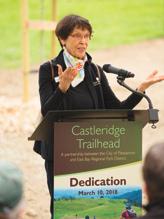
“I was very lucky,” says Wieskamp. “I could afford to do community service. You realize how important it is for communities to have people working together to make change. Not everyone has the time and energy for community service, but where you can help, do it.”
She leaves a lasting stamp on the Park District as well, including her longtime advocacy for park development at the former Dumbarton Quarry site in Fremont. Her 20-year vision was realized with the opening of the Dumbarton Quarry Campground on the Bay in 2021.



“You want things to happen fast, but it’s just not possible,” says Wieskamp. “We are trying to protect as much logical open space as we can, all while protecting resources and providing access for people too. It’s a balance that is not always easy to accomplish.”
In addition to Dumbarton Quarry Campground on the Bay, Ward 5 includes parks in Sunol, Dublin, Pleasanton, Newark, Fremont and Union City. Wieskamp calls Livermore’s Brushy Peak Regional Preserve (“the first park I opened”) and Ardenwood Historic Farm in Fremont two of her favorite parks.
“Ardenwood is wonderful because you see so many people, families with little kids, experiencing farm life. It’s just a very unique place,” she says. “Brushy Peak is ideal for those who want to hike. You can do so many different things in the Park District, enjoy them and tell all your friends.”
BOARD SPOTLIGHT
EBRPD COMPASS < 5
Building the Next Generation of Stewards

i

6 > REGIONAL PARKS FOUNDATION


EBRPD
COMPASS < 7
programs around the Park District support youth development while nourishing a lifelong love of nature i
Teen Eco Action Week participants enjoy programming at Black Diamond Mines Regional Preserve.
It’s no secret that kids thrive in the great outdoors. But the East Bay Regional Park District is doing something far more impactful than simply getting young people outside. It’s sowing the seeds of stewardship.


Through various educational programs, EBRPD is helping kids develop a lifelong love and respect for nature—and the Park District itself. “What we’re trying to do is breed a sense of joy,” says Michael Moran, regional interpretive and recreation services manager, north/west region. “We’re not hammering facts and figures and wagging fingers. We’re helping people understand that these are their parks and see them as a positive and fun part of their lives.”
According to Moran, getting youth involved early and repeatedly is key. “Kids are the purest ambassadors,” he says. “Some are in the same program year after year, developing a real sense of understanding and stewardship of the land, and often wanting to return with their family. Those people turn into park fans, advocates and, ultimately, stewards.”

8 > REGIONAL PARKS FOUNDATION EBRPD
From left: Watersheds Apprenticeship students at Robert W. Crown Memorial State Beach and Dr. Aurelia Reinhardt Redwood Regional Park.
Promoting Service and Employment i
Working with community partners in Pittsburg, Richmond and Union City, Teen Eco Action Week is a summer program connecting the youth in these East Bay cities with their local parks. Along with recreational activities like swimming, fishing, canoeing and hiking, the kids, ages 11 to 17, do service projects such as shoreline cleanups, habitat restoration and maintenance work in pollinator gardens. At Miller/Knox Regional Shoreline in Richmond, they spent one morning cleaning trash from the picnic and beach area. Returning later, the participants found younger children playing in a clean and healthy environment.
“It was so good for them to see that, because of their leadership and ownership in beautifying the space, people were able to utilize and enjoy it,” says Melissa Fowlks, naturalist at Tilden Nature Area in Berkeley.

Thanks to funding from the Regional Parks Foundation, the Teen Eco Action Week participants receive a $200 stipend. But they also take part in career talks and job skills workshops where they learn how to apply for entry-level employment with the Park District. Some past attendees now work for the parks full time.
“We try to have a teen-to-job pipeline so whenever we review applications and we see somebody who has really stood out in one of our programs, that really helps our evaluation process,” says Kelsey Gielen, outdoor recreation supervisor. “It’s nice to come full circle and hire these folks into their first jobs.”

Helping Hands i

A happy side effect of stewardship programs is that they provide extra help to park staff. With 73 parks encompassing 125,470 acres and a recent spike in visitors, those additional hands are welcome, and needed. “We simply can’t do all this by ourselves,” says Moran. “The more folks we have caring, the better. We really depend on people to become the stewards, take ownership of different projects and help us out.”
The Watersheds Apprenticeship does just that. With recruitment aid from nonprofit partner Urban Tilth, the program provides 16 weeks of paid summer training for Richmond youth ages 18 to 26. “Typically, these are not kids who were brought up with nature at an early age,” says Kristen Van Dam, an ecologist in the Stewardship Department. “A lot of these folks have never been to
Kids explore the natural wonders of Wildcat Canyon Regional Park.
COMPASS < 9
Adventure Crew members at the Peralta Hacienda Center for History and Community in Oakland.
EBRPD
This page: Young people take part in stewardship projects at regional parks. Opposite page: Agents of Change members survey wildlife in the bay, such as the pipefish.

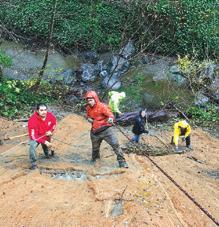



10 > REGIONAL PARKS FOUNDATION EBRPD
Alvarado Park in Wildcat Canyon Regional Park, and it’s only 5 miles from them. We hike up into the canyons and they are just amazed at how beautiful it is.”
Most recently, apprentices helped with watering, landscaping and care of 1,500 square feet of new pollinator and monarch butterfly habitat at Point Pinole.
“One of the most important parts of this program is that the crew is helping park staff in the field do work they normally wouldn’t be able to do because it’s above and beyond their already full schedule,” says Van Dam. “We have a bunch of rangers interested in resource protection and restoration, but they just don’t have the staffing capacity. The apprentices give them a set of hands to make their projects come to life, making the difference between the job getting done or not.”
Similarly, in Tilden Nature Area, they worked on streambased restoration, soil bioengineering (using plants to stabilize stream banks), fixing trails and native plant maintenance.
Special Agents i

One of the Park District’s unique programs, Agents of Change, educates youth ages 13 to 17 about the environment, global ecology and climate change through the power of hip-hop. “We really turn the standard environmental education format on its head,” says Constance Taylor, naturalist with the Mobile Education Program. “We are engaging on a level that the kids are already comfortable in and so they are much more willing to absorb new information within the context of hip-hop.”
These kids also perform some exceptional work. Last year, as part of an ongoing scientific survey of animals in the bay with the California Department of Fish and Wildlife, they did seine netting at Robert W. Crown Memorial State Beach in Alameda. “We take a giant net and work together to drag it through the water,” says Taylor. “We’re in the outer area of protected eelgrass beds in the bay, so we can find really cool stuff like pipefish, our native seahorse.”
The weeklong program has a youth mentorship component in which participants return as mentors responsible for the integration of new kids as well as some teaching. “Kids always want to come back,” says Taylor. “They’re like, ‘Wait, can we do this all year round?’ ”
Building Love for the Outdoors i
One stewardship program that is (almost) year-round is Adventure Crew. Composed of the Richmond Rangers and Oakland Naturalists, the program partners with YES Nature to Neighborhoods and Peralta Hacienda Historical Park. Adventure Crew runs from October to June. Similar to Tilden Nature
Area’s Junior Rangers, it recruits from neighborhoods where access to nature might be limited.
“You have to love something to want to care for it,” says Claudia Muñoz, supervising naturalist with the Mobile Education Program. “Adventure Crew builds that love for the outdoors. It builds memories at these places and a long-standing relationship with not just each other but also with the parks.”
(To see some of the District’s published studies about Adventure Crew, visit ebparks.org/AdventureCrewResearch.)

For participants ages 10 to 14, Adventure Crew offers two park excursions a month. In addition to helping rangers, the young people fish, kayak and hike, learning outdoor skills that culminate in a three-night backpacking trip in Point Reyes. “It can be hard—backpacking isn’t easy,” says Muñoz, “but, at the end, the kids say it’s worth it to camp out under the stars, go to the
beach at Point Reyes or see the view from the mountaintop.”
Building resilience is no small feat, and coordinators are noticing another positive effect on the kids’ mental health. Being outside relaxes them. “It allows them to get away from some hectic things that might be happening at home,” says Fowlks. “It’s a no-judgment zone where they can just be themselves, have time to reflect and slow down a bit.”
Moran agrees. “There’s been no end of studies that show how important it is to be outside in an unstructured setting,” he says. “There’s no artifice out there. You’re not getting a direction as to how to act. Parks give folks an opportunity to become their best self—their whole self.”
“You have to love something to want to care for it. Adventure Crew builds that love for the outdoors. It builds memories at these places and a long-standing relationship with not just each other but also with the parks.”
COMPASS < 11 EBRPD
Claudia Muñoz, supervising naturalist with the Mobile Education Program
WELCOME

 TOP TO BOTTOM: EBRPD, CALI GODLEY
TOP TO BOTTOM: EBRPD, CALI GODLEY
12 > REGIONAL PARKS FOUNDATION
From top: The recently improved visitor center at Livermore’s Del Valle Regional Park; the new interpretive pavilion at Shadow Cliffs Regional Recreation Area in Pleasanton.
UPDATES

The Park District has renovated several facilities to further enhance the visitor experience

Visitor centers are essential components of the regional parks, orienting people to what makes each location unique. The centers familiarize guests with the animal and plant life surrounding them, impart the cultural history of the area, foster an appreciation for past efforts to preserve these lands for all to enjoy, and create a place for communities to come together in their parks.
“The recent renovations welcome visitors to new nature experiences and environmental education opportunities,” says Susan Shiu, interim executive director of the Regional Parks Foundation. “These improvements and enhanced exhibits are a tremendous gift to the community, and made possible with support from the Regional Parks Foundation members and donors.”
COMPASS < 13
DEL VALLE REGIONAL PARK VISITOR CENTER
In recent years, the Foundation spearheaded an upgrade of the visitor center at Del Valle Regional Park in Livermore. The spiffy renovated facility opened in April 2021, nearly tripling in size within the same footprint by taking over a former concession stand that was housed in the building. And what was once open only seasonally now operates year-round. The whole process, from planning to the opening of the building’s massive double doors, took about three years.
“The main concept of the renovation was to allow people to discover the natural world around them,” says Kevin Damstra, regional interpretive and recreation services manager for the south/east region.
The state-of-the-art exhibits, with interpretive panels in both English and Spanish, provide a look at indigenous people who inhabited the area, as well as the ranchers who followed. Understanding watersheds and the value of water is an educational focus as Lake Del Valle is the centerpiece of the park. Not only does the 5-mile-long lake offer swimming, windsurfing and boating, it also serves as a storage reservoir for the South Bay Aqueduct. Given the importance of water in these droughtplagued times, the center helps teach visitors about this critical resource. One very popular exhibit gives visitors a chance to act as water manager, regulating water flow in response to rain. They
—KEVIN DAMSTRA, REGIONAL INTERPRETIVE AND RECREATION SERVICES MANAGER, SOUTH/EAST
REGION
can choose to divert the water or watch a flood engulf the town of Livermore. And a digitally enhanced sand table lets users construct a model of a watershed, discovering how different geographical features determine where water ultimately ends up.

The revamped facility is proving very popular. In 2015, the center had some 1,400 visitors; attendance has since grown to 14,000 a year. “It’s a popular park, with lots of picknickers and overnight campers,” says Damstra. “And it hasn’t reached its full potential yet.”
SHADOW CLIFFS REGIONAL RECREATION AREA INTERPRETIVE PAVILION
This past December, the Park District celebrated the opening of a new 1,000-square-foot interpretive pavilion at Shadow Cliffs Regional Recreation Area in Pleasanton. The pavilion, funded in part by a generous donation from Pleasanton residents Gary and Nancy Harrington, will serve as an outdoor visitor center and connection point to Shadow Cliffs’ 116 acres of open space.

“The nature pavilion is an important new facility that helps advance the Park District’s mission of providing healthy recreational opportunities and environmental education,” says General Manager Sabrina Landreth. “We are proud to provide yet another improvement and enhanced experience for the community.”
The nature pavilion at Shadow Cliffs will serve as a gathering spot for naturalist-led programs and allow the Park District to serve even more children.
Thousands of schoolchildren visit Shadow Cliffs each year to participate in naturalist-led programs at the park. Beginning in fall 2023, the nature pavilion will serve as a gathering spot for
LEFT TO RIGHT: CALI
EBRPD
GODLEY,
14 > REGIONAL PARKS FOUNDATION
“
The main concept of the renovation was to allow people to discover the natural world around them.”
The renovated Del Valle visitor center has expanded space and displays.
those programs and allow the Park District to serve even more children each year. The new pavilion includes educational exhibits highlighting the park’s wildlife and natural and cultural history, as well as park maps and information. While Shadow Cliffs is best known for its lake and water-based recreational activities—including swimming, fishing and lakeside picnicking—the pavilion will help introduce visitors to the other engaging options available at the park.
“Shadow Cliffs is a small regional park, but it’s overflowing with opportunities to experience and learn about nature,” says Gary Harrington. “As former educators, Nancy and I understand the value of hands-on learning and saw an outdoor pavilion as a way to encourage visitors to explore nature in the park and help create a place where school-age children could learn about nature, wildlife and the environment.”
The pavilion was made possible by California State Parks, the Harringtons, the Regional Parks Foundation, the Wayne and Gladys Valley Foundation, and individual supporters.
SUNOL WILDERNESS REGIONAL PRESERVE VISITOR CENTER

The former dairy barn that serves as the Sunol Wilderness Regional Preserve visitor center underwent a Foundation-supported renovation too—an upgrade that was rather urgent. “We had our own ecosystem in the visitor center,” laughs Anne Kassebaum, former chief of interpretive and recreation services.
Over the years, the building’s attic had become home to over 400 bats. “We found rodents, too, and a snake in the wall!” says Damstra. The entire building was gutted and redone inside, but the historic structure and feel of the exterior were maintained.
Two light-filled rooms house exhibits that showcase the history of the land, from its time as the home of indigenous tribes through its transition to a thriving ranching community. “We want to orient visitors to the surrounding backcountry that comprises the park,” says Damstra. “A lot of research and stewardship occurs here, monitoring endangered and threatened species, like red-legged and yellow-legged frogs.” Some of the research is undertaken by the Park District, some by other partner agencies. Naturalists lead walks, hikes, birding outings, and arts and crafts activities. They also introduce visitors to the park’s animal ambassadors—a gopher snake, a northern Pacific rattlesnake, a California toad, a western pond turtle and a tarantula.
As for the displaced bats, the population is thriving. The center’s attic was cleared out during a time when they weren’t roosting. And newly erected bat boxes provide ample quarters for the insect-devouring animals.

To support enhancements to education programs and experiences, visit RegionalParksFoundation.org/support-us.

From top: The aging internal structure of the original visitor center at Sunol Wilderness Regional Preserve; new exhibits highlight the park’s wildlife population.

BIG BREAK’S BIRTHDAY
The visitor center at the Big Break Regional Shoreline in Oakley first opened its doors in 2012 and is now celebrating 10 years of providing insights into the area’s rich history, as well as the ecosystem and wildlife of the Sacramento-San Joaquin River Delta. The building is certified by the Green Building Initiative for green building design, construction and facility operations. For more information about interpretive programs at Big Break, visit ebparks.org.
COMPASS < 15 EBRPD
Gateway to the Outdoors
The Tyler Ranch Staging Area provides a new entrance to the open-air attractions at Pleasanton Ridge Regional Park

Since 1990, countless visitors have enjoyed the breathtaking scenery and multipurpose trails at Pleasanton Ridge Regional Park, a 9,000-plus-acre open-air haven with spectacular views of the Livermore Valley. Now, guests can take advantage of the brand-new Tyler Ranch Staging Area at the southern side of the park in Sunol, an ideal home base for those about to venture onto the trails.
In the works since 2012 as part of the Pleasanton Land Use Plan, Tyler Ranch Staging Area’s construction officially started in September 2021. It features 70 gravel parking spots, four ADA-accessible concrete paved spots and spaces for those visiting the park with trailers or horses. Other amenities include a picnic area, a drinking fountain and restrooms.
The staging area is part of the larger historic Tyler Ranch property, a one-time cattle ranch that still features a pasture, workshop, barn, old corrals and more. The Park District team also plans to open approximately 12 miles of existing paths on the nearby Robertson property that will be accessible through the staging area, along with the new Tyler Ranch Trail—providing 2,800 acres of fresh territory to explore.
Pleasanton Ridge is a popular destination for equestrians, cyclists and hikers of all ages (as well as their canine friends). The park also provides bird-watchers the chance to spot red-tailed hawks and western bluebirds, while California quail, newts, western pond turtles and bullfrogs are also among the many species known to populate the area.
Visitors love taking in the panoramic sights visible from the ridgetop as well as discovering the hidden streams in canyons throughout the natural wonderland. History buffs might know that the land was once home to the prune, cherry, apricot and almond orchards of the Thermal Fruit Company and continues to house olive trees that date back as far as the 1890s. The late winter and spring seasons are also the perfect times to take the family to Pleasanton Ridge for a wildflower-spotting trip; look for blooming varieties such as California buckeyes, morning glories and sweet fennel, among many others.

FAMILY ZONE
16 > REGIONAL PARKS FOUNDATION
Fresh Finds
Park visitors and staff celebrate special events and new attractions at community events throughout the District.
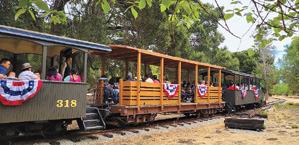



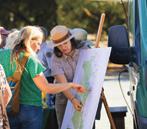

1 Guests attend a ribbon cutting at the Regional Parks Botanic Garden’s new crevice garden in August. 2 An October Wellness Walk at Contra Loma Regional Park honors Día de los Muertos. 3 Staff offer a preview of Pleasanton Ridge’s new Tyler Ranch Staging Area. 4 Pebbles from Roberts Regional Recreation Area are part of a mural commemorating the 60th anniversary of Oakland and sister city Fukuoka City, Japan. 5 A September Olmsted 200 reception recognizes the District's connection with noted landscape architect Frederick Law Olmsted Sr. 6 Ardenwood Historic Farm opens a new loop on its train route. 7 Visitors celebrate the 2022 International Day of Peace at Lake Chabot in September.

EBRPD SNAPS COMPASS < 17
From Golf Course to Parkland
Former rodeo superstar Jack Roddy loved Antioch and its environs, cattle ranching there for decades while also starting a philanthropic foundation and serving as a mentor to local youth.
In 2000, he created a golf course on a portion of his land. When Roddy and his wife decided to retire out of state, the property was gradually acquired by the Park District. The final piece—the 230-acre golf course—was purchased with funding from the East Contra Costa County Habitat Conservancy and Measure WW, approved by voters in 2008. True to Roddy’s vision, this entire area will become parkland as part of the future 3,700-acre Deer Valley Regional Park.
The first section to be tackled is the former golf course, which closed in 2016. EBRPD planner Edward Willis, project coordinator for the golf course reclamation, explains that it makes sense to start there, since the terrain has already been disturbed and the habitat is less sensitive.

“The major mission of the restoration is habitat conservancy, restoring grasslands and wetlands,” he says. Rehabilitated ponds will provide a home for newts and frogs, including the California red-legged frog and California tiger salamander. Willis hopes that grasslands will welcome native birds and other wildlife. Ground squirrels will also be encouraged to take up residence. Often regarded as pests, “they are actually
a keystone species, serving as food for coyotes and golden eagles,” says Willis.
Public access is included in the plan, with parking, restrooms, drinking water and an all-weather-surface trail to enable year-round access, as well as multiuse trails for hikers, bikers and equestrians. The trails have been carefully plotted so that they don’t interfere with potential new habitat areas. A proposed interpretive pavilion will provide a gathering space for environmental education. And as the time for planting and tending comes, there will be opportunities for volunteers to have hands-on involvement.
The property will continue to be grazed to manage vegetation and reduce fire risks. “Grazing the land is also a nod to the Roddy legacy,” says Willis. As many golf courses around the country are facing closure due to water limitations, he hopes this conversion to parkland will serve as a model for the future.
 The future Deer Valley Regional Park in Antioch will provide restored habitats for wildlife, as well as open space and trails for park visitors
The future Deer Valley Regional Park in Antioch will provide restored habitats for wildlife, as well as open space and trails for park visitors
PARKS ALIVE
18 > REGIONAL PARKS FOUNDATION
The future Deer Valley Regional Park
Take
MARK YOUR CALENDAR
Bring family and friends to these highlighted EBRPD programs and activities—perfect for nature lovers and fun seekers of all ages. To view complete listings of events, visit ebparks.org/calendar.
SPECIAL EVENTS
Martin Luther King Jr. Day of Service
On Jan. 16, the Park District will celebrate its annual Day of Service, which continues Dr. Martin Luther King Jr.’s legacy of service to the community and honors the spirit of the day. Participate throughout the month by cleaning your neighborhoods, parks and other local areas, or attend the annual shoreline cleanup event on Jan. 16 at Martin Luther King Jr. Regional Shoreline. Register at ebparks.org/get-involved/volunteer.
Tilden Fungus Fair
Celebrate the bounty of winter! View hundreds of local mushroom specimens, mingle with the mycological community, and enjoy presentations by guest speakers
at this two-day special event on Jan. 28 and Jan. 29 at Tilden Nature Area. Or watch from home—presentations will be livestreamed on YouTube.
Day by the Water
In observation of World Water Day (March 22), stop by the Del Valle Regional Park visitor center on March 25 for a day celebrating water. Learn about water conservation while enjoying one of the water-themed activities, head out on a guided shoreline walk and much more.
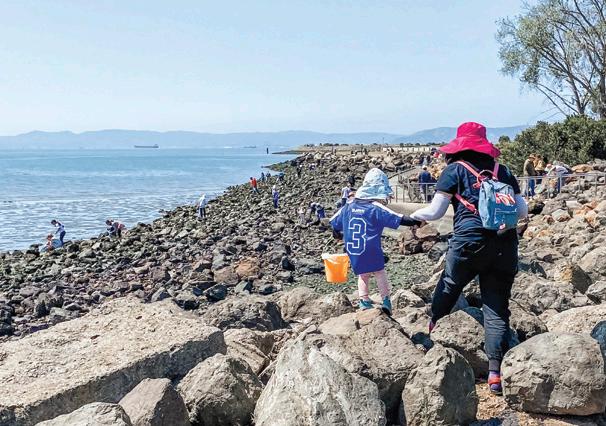
Wildflower Season at Sunol
Each year from the end of March to the beginning of May, a rich diversity of wildflowers bloom in Sunol Wilderness Regional Preserve and the Ohlone
Wilderness. Experience the season through videos, printable activities and guides, and naturalist-guided programs. Learn more at ebparks.org/parks/nature/wildflowers.
Earth Day Events
Earth Day is April 22, but every day is Earth Day in the Park District, and there are all kinds of ways to celebrate and honor the planet. Join us for an Earth Day-themed activity, take a hike or ride in nature, or volunteer at an Earth Day cleanup event in a park or in your neighborhood. Events are scheduled throughout the month of April. Visit ebparks.org/we-celebrate/earth-day for ways to get involved.
CALI GODLEY WHAT’S UP COMPASS < 19
part in Earth Day events at parks such as Robert W. Crown Memorial State Beach.

Supp or t ing E ast B ay Re g ional Par ks JOIN US! Your investment of $21 ($250/year) will enroll you in the 1-in-a-Million Donor Circle. Together, 4,000 donors will raise $1 million annually to fund environmental restoration and protection of open space. To give online, visit: RegionalParksFoundation.org/MIL or call (510) 544-2202 NONPROFIT ORG U.S. POSTAGE PAID OAKLAND, CA PERMIT NO. 648
Box
Regional Parks Foundation P.O.
2527 Castro Valley, CA 94546 www.RegionalParksFoundation.org

































 TOP TO BOTTOM: EBRPD, CALI GODLEY
TOP TO BOTTOM: EBRPD, CALI GODLEY


















 The future Deer Valley Regional Park in Antioch will provide restored habitats for wildlife, as well as open space and trails for park visitors
The future Deer Valley Regional Park in Antioch will provide restored habitats for wildlife, as well as open space and trails for park visitors

